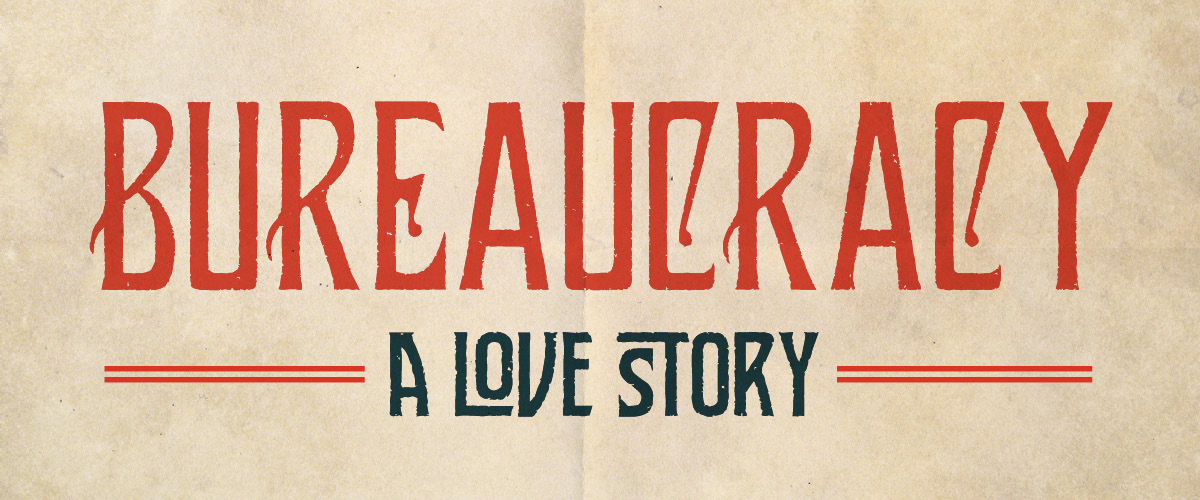Bureaucracy is arguably one of the most loathed inventions of Western modernity. Yet, even as we complain about red tape, paperwork and Wikipedia, we also love to hate it—because we (clandestinely) rely on it to structure our world.
This exhibit draws from UNT’s Archival and Rare Book collections to explore our relationship with the myriad genres of bureaucratic writing. The objects collected here reveal how, over the past 350 years, people have strategically employed—and creatively misused—the written and printed forms of bureaucracy to structure and navigate their everyday lives.
Bureaucracy is everywhere, but it becomes palpable and real for most people when they meet with its material, written forms. The exhibit includes several types of objects: documents like diplomas and land deeds, reference books like encyclopedias and dictionaries, and catalogues of plants and college courses. While these kinds of writing may seem very different, together they provide the foundation for all bureaucratic systems. Bureaucracy is most often associated with the government—think of tax forms or the line at the DMV—but it also structures schools, academic disciplines, professional organizations, and even our personal lives (in the form of a marriage license, loan agreement, or report card). Bureaucracy would not exist without documents that collect and store information, catalogues that organize and classify it, and reference books that consolidate and synthesize it.
Whatever form it takes, bureaucracy never simply exists—it is always in process, being filled out and filed, compiled or annotated, amended, corrected, expanded and republished. This exhibit tells the story of bureaucracy by tracing how it works and what it does. Bureaucracy aims to order our world by classifying and accounting for all its moving parts, but it is always, fundamentally, about doing things, making things happen. For individuals, it legitimates our promises to each other, helps us place ourselves in the world, and produces an archive that helps us remember where we came from. Within institutions, bureaucracy aims to streamline processes to make them more efficient, but it also multiplies and complicates the procedures for earning credentials and moving forward. At its most abstract, bureaucracy serves to discipline, setting boundaries and limits on our knowledge, bodies and minds—and for this reason, we resist its power even when we cannot help but inhabit its structures.
The exhibit was conceived and curated by a group of faculty in the English department: Dr. Gabriel Cervantes, Dr. Dahlia Porter, Dr. Ryan Skinnell, and Dr. Kelly Wisecup. Research and written text for the labels was contributed by the students in Dr. Porter’s graduate seminar, English 5750: Methods of Historical Research, and Dr. Skinnell’s undergraduate seminar, English 4230: Institutional Rhetorics. The following list indicates which students contributed to each portion of the exhibit.
Classifying: Demetrius Chapman, Victoria Forman, Aaron Peiser, Cavyn Smith, Danny Vasquez, Carol Walker, Kayla West, Kaitlyn Willy
Doing/Making: Christina Baines, Josh Lein, Christine Whitten
Promising: Demetrius Chapman, Danica Gregory, Josh Lein, Sarah Pierce
Accounting: Dylan King, Taylor Durham, Mary Kate Motley, Leslie Stewart-Gordon, Carol Walker, Kaitlyn Willy
Credentialing: Kelly Bryant, Taylor Durham, Emily Menton, Charles Pawluk, Ashley Schumacher, Ryan Munthe
Disciplining: Kelly Bryant, Matt Cowles, Stacy Ming, Mary Kate Motley, Jessica Murray, Daniel Stuart, Michael Young
Remembering: Charlie Baxter, Matt Cowles, Victoria Forman, Alison Lowe, Tsung Che Lu, Kayla West
Streamlining: Christina Baines, Kelli Gill, Alison Lowe, Emily Menton
Locating: Danica Gregory, Tsung Che Lu, Aaron Peiser, Ashley Schumacher, Kayla West, Alex Wray
Resisting: Kelly Bryant, Stacy Ming, Jessica Murray, Charles Pawluk, Leslie Gordon-Stewart, Daniel Stuart, Carol Walker, Kaitlyn Willy, Alex Wray, Michael Young
